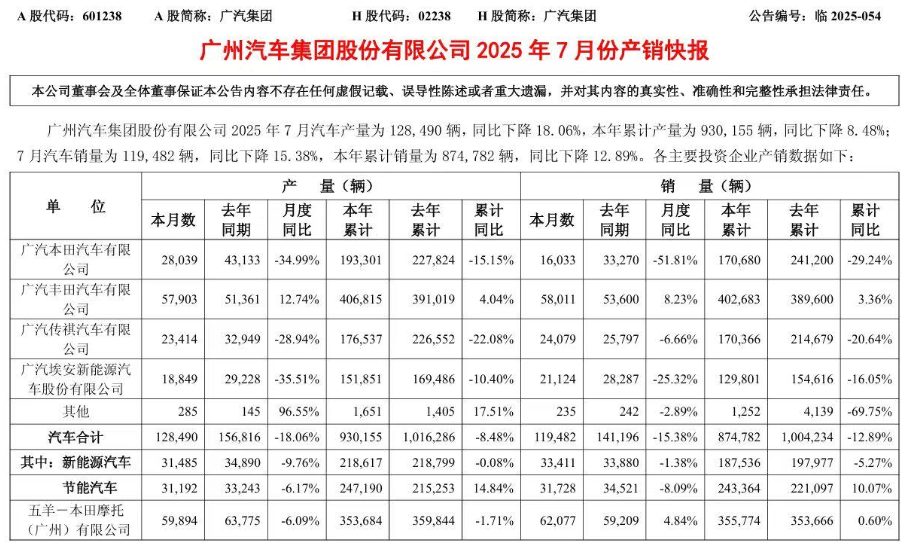GAC Honda’s July 2025 Sales Plummet by 51.8% Year-on-Year: Can Honda Make a Comeback in the Chinese Market?
View 1:
Probably not. At best, the future for GAC Honda looks like models such as the Ye P7 – new energy vehicles developed by the local R&D team that are essentially rebadged cars. Apart from the Honda badge, everything else – design, R&D, manufacturing, marketing – is made in China. It’s just the name that’s associated with Honda.
Furthermore, even this “best-case” scenario likely means becoming the French or Korean car brands of the new energy era: low volume, surviving under the umbrella of the GAC Group. Over time, it might still end up leaving the Chinese market like Mitsubishi did.
The worse direction is failing the new energy transition outright, directly following the path of French cars: becoming completely irrelevant until exiting the Chinese market.
View 2:
- Fully promote hybrid models across the lineup, cutting prices by another 20,000 RMB, making hybrids only 8,000-10,000 RMB more expensive than pure gasoline versions.
- Keep only the Civic/Integra, HRV/ZRV, CRV/Breeze, Accord/Inspire, Crown Passport/URV. Discontinue all other models directly. Use the sedan platform for pure gasoline/hybrids, and the SUV platform for pure gasoline/hybrids/PHEVs.
- Keep the shells of the Fit, Lingpai, and XRV, but convert them all into pure electric models. A range of 300-400 km is sufficient. Slash prices to compete directly with domestic small cars, relying on more substantial offerings to grab customers.
- Replace all interior plastic shells with soft-touch materials and dual-tone schemes. Optimize sound insulation further.
- Stop developing their own EVs like the P7. Learn from neighbors Toyota (bZ) and Nissan (N7) – just rebadge and badge-engineer models from their Chinese partners.
- Buy cheap and usable smart driving solutions from domestic suppliers. Equip the entire lineup with a Momenta smart driving system.
- Upgrade configurations: add rear parking radar for base models, front and rear radar for mid-trim, and front/rear radar plus 360° camera for high-trim.
Do all of the above immediately, and they will make a comeback instantly, becoming the number one joint venture automaker again.
- Comment 2.1: Isn’t this the death knell for Japanese suppliers? They’ve supported Honda for 50-60 years, with cross-shareholdings. You can’t just ditch them! Honda won’t go electric until Japanese suppliers complete their electrification transformation!
- Comment 2.2: Your suggestions either ask Honda to cut prices, increase costs, or admit their technology is inadequate (the rebadging point). Honda would rather die than do that.
- Comment 2.3: GAC: What about my Aion brand? / Honda: What about my parts suppliers?
View 3:
Domestically, it’s definitely not working. Toyota will be fine for a short while, but Honda is certainly in danger. However, it won’t die outright because it has captive markets like the US, Taiwan, etc. In free markets where brands battle it out, domestic cars will dominate, like in Hong Kong and Singapore.
View 4:
It’s 2025, and Honda still charges an extra 2000 RMB for choosing white paint.
I can only say, if Honda really wants to make a comeback, it needs to stop being so “courageous”.
It feels like Honda has already given up trying in the Chinese market and is focused on squeezing money out of Americans instead.
View 5:
No.
The arguments from over a decade ago about Apple and Nokia
Still echo in my ears.
Survival or elimination
Never lies in viewpoints or stances
Nor in debates or data
But in who represents the more advanced productive forces
Who brings humanity more tangible convenience and benefits.
View 6:
This is already the best time for Japanese cars; it will only get worse year after year. If Chinese people didn’t buy Japanese cars and Apple phones, the Japanese economy would have collapsed long ago. Where would they get the confidence to threaten war with China? Apple’s profits mostly flow overseas; Japan takes about 34%, while China gets less than 4%. If Chinese people buy more Huawei, since Huawei is 100% domestic, domestic employment and income would increase. This is the real reason Huawei has been constantly smeared.
View 7:
Honda never really had unique or formidable product strength; it felt more like an individual stock following the broader market trend. My label for it is: among Japanese brands, it’s the one focused on sportiness and dynamism. But the models are always the same few: Fit, Civic, Accord, CRV. The Civic and CRV are still with Dongfeng Honda; GAC can only release sister models. Acura, which constantly boasted about sportiness and handling, didn’t even offer sedans and ended up leaving the market quietly. The slightly notable Type R was introduced, priced not too high, but made no waves.
That era is over.
View 8:
Ten years ago when I was buying a car, all the media raved about the Fit – fuel-efficient, spacious, fun to drive, cheap maintenance… Today, it feels like a dream.
PS. I ended up buying a Škoda Rapid Spaceback (wink).
View 9:
Not just Honda; Toyota, Nissan, and other Japanese cars will inevitably be the first to exit the Chinese market within 5 years. American cars will follow. In 5-10 years, only the discounted German luxury brands (BBA) and domestic brands will coexist. After 10 years, domestic brands will unify the market.
View 10:
Not far from death. As a 6-year Honda gasoline car owner, I went to the 4S dealership for maintenance two months ago. The centerpiece was an electric car, probably the S7. I said I’d sit in it to see how this EV was made. Good grief! Getting in felt like being in a domestic car from 7-8 years ago. Almost no sense of quality, underwhelming tech feel, and they still wouldn’t spring for soft-touch interiors… Forget about Xiaomi/NIO/Xpeng/Li Auto/Huawei; even Changan/Geely/Chery are better than this. How does this thing expect to compete with popular domestic models? It probably doesn’t even get a seat at the table.





Hey guys! Been playing on 567win1 for a bit now and gotta say, it’s pretty solid. Good selection of games and haven’t had any issues with withdrawals. Give it a shot and let me know what you think!